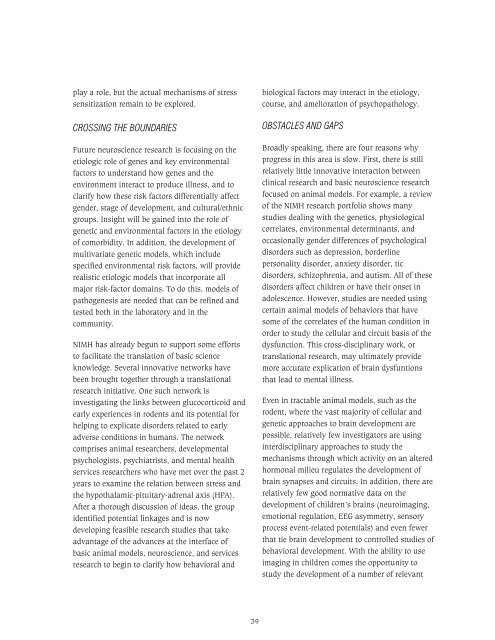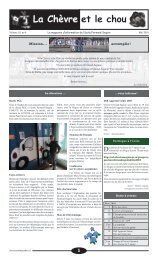Research on Child and Adolescent Mental Health
Research on Child and Adolescent Mental Health
Research on Child and Adolescent Mental Health
Create successful ePaper yourself
Turn your PDF publications into a flip-book with our unique Google optimized e-Paper software.
play a role, but the actual mechanisms of stress<br />
sensitizati<strong>on</strong> remain to be explored.<br />
CROSSING THE BOUNDARIES<br />
Future neuroscience research is focusing <strong>on</strong> the<br />
etiologic role of genes <strong>and</strong> key envir<strong>on</strong>mental<br />
factors to underst<strong>and</strong> how genes <strong>and</strong> the<br />
envir<strong>on</strong>ment interact to produce illness, <strong>and</strong> to<br />
clarify how these risk factors differentially affect<br />
gender, stage of development, <strong>and</strong> cultural/ethnic<br />
groups. Insight will be gained into the role of<br />
genetic <strong>and</strong> envir<strong>on</strong>mental factors in the etiology<br />
of comorbidity. In additi<strong>on</strong>, the development of<br />
multivariate genetic models, which include<br />
specified envir<strong>on</strong>mental risk factors, will provide<br />
realistic etiologic models that incorporate all<br />
major risk-factor domains. To do this, models of<br />
pathogenesis are needed that can be refined <strong>and</strong><br />
tested both in the laboratory <strong>and</strong> in the<br />
community.<br />
NIMH has already begun to support some efforts<br />
to facilitate the translati<strong>on</strong> of basic science<br />
knowledge. Several innovative networks have<br />
been brought together through a translati<strong>on</strong>al<br />
research initiative. One such network is<br />
investigating the links between glucocorticoid <strong>and</strong><br />
early experiences in rodents <strong>and</strong> its potential for<br />
helping to explicate disorders related to early<br />
adverse c<strong>on</strong>diti<strong>on</strong>s in humans. The network<br />
comprises animal researchers, developmental<br />
psychologists, psychiatrists, <strong>and</strong> mental health<br />
services researchers who have met over the past 2<br />
years to examine the relati<strong>on</strong> between stress <strong>and</strong><br />
the hypothalamic-pituitary-adrenal axis (HPA).<br />
After a thorough discussi<strong>on</strong> of ideas, the group<br />
identified potential linkages <strong>and</strong> is now<br />
developing feasible research studies that take<br />
advantage of the advances at the interface of<br />
basic animal models, neuroscience, <strong>and</strong> services<br />
research to begin to clarify how behavioral <strong>and</strong><br />
biological factors may interact in the etiology,<br />
course, <strong>and</strong> ameliorati<strong>on</strong> of psychopathology.<br />
OBSTACLES AND GAPS<br />
Broadly speaking, there are four reas<strong>on</strong>s why<br />
progress in this area is slow. First, there is still<br />
relatively little innovative interacti<strong>on</strong> between<br />
clinical research <strong>and</strong> basic neuroscience research<br />
focused <strong>on</strong> animal models. For example, a review<br />
of the NIMH research portfolio shows many<br />
studies dealing with the genetics, physiological<br />
correlates, envir<strong>on</strong>mental determinants, <strong>and</strong><br />
occasi<strong>on</strong>ally gender differences of psychological<br />
disorders such as depressi<strong>on</strong>, borderline<br />
pers<strong>on</strong>ality disorder, anxiety disorder, tic<br />
disorders, schizophrenia, <strong>and</strong> autism. All of these<br />
disorders affect children or have their <strong>on</strong>set in<br />
adolescence. However, studies are needed using<br />
certain animal models of behaviors that have<br />
some of the correlates of the human c<strong>on</strong>diti<strong>on</strong> in<br />
order to study the cellular <strong>and</strong> circuit basis of the<br />
dysfuncti<strong>on</strong>. This cross-disciplinary work, or<br />
translati<strong>on</strong>al research, may ultimately provide<br />
more accurate explicati<strong>on</strong> of brain dysfunti<strong>on</strong>s<br />
that lead to mental illness.<br />
Even in tractable animal models, such as the<br />
rodent, where the vast majority of cellular <strong>and</strong><br />
genetic approaches to brain development are<br />
possible, relatively few investigators are using<br />
interdisciplinary approaches to study the<br />
mechanisms through which activity <strong>on</strong> an altered<br />
horm<strong>on</strong>al milieu regulates the development of<br />
brain synapses <strong>and</strong> circuits. In additi<strong>on</strong>, there are<br />
relatively few good normative data <strong>on</strong> the<br />
development of children’s brains (neuroimaging,<br />
emoti<strong>on</strong>al regulati<strong>on</strong>, EEG asymmetry, sensory<br />
process event-related potentials) <strong>and</strong> even fewer<br />
that tie brain development to c<strong>on</strong>trolled studies of<br />
behavioral development. With the ability to use<br />
imaging in children comes the opportunity to<br />
study the development of a number of relevant<br />
39

















